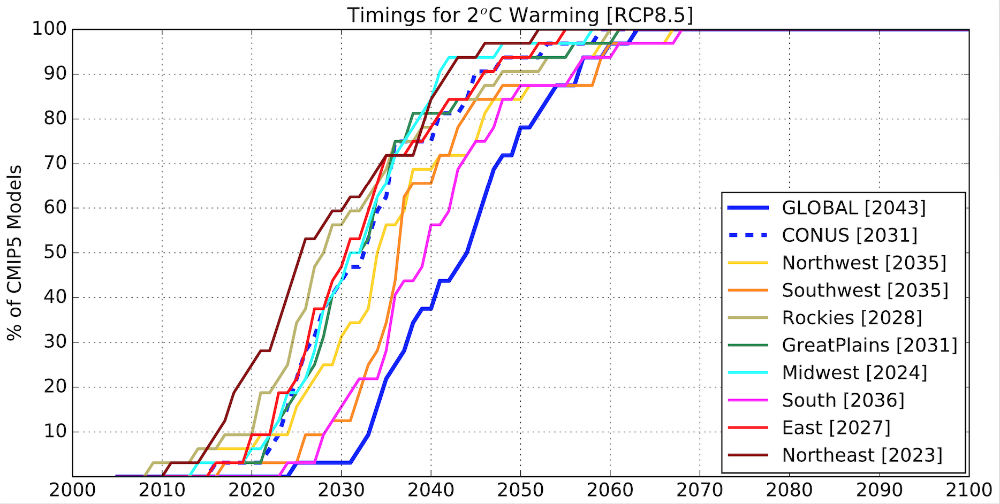Temperatures across the United States will increase much faster than the global average, scientists predict, and the northeast of the country has been singled out as fastest warming region of them all.
Based on new climate models, we should expect the Northeastern US to warm 50 percent faster than the planet as a whole, meaning it will have warmed by 3°C (5.4°F) by the time global warming reaches 2°C (3.6°F).
To give you an idea of how big a 3°C increase is, as this XKCD infographic shows, a difference of around 4°C (7.2°F) on average is all that separates us from the peak of the last ice age 20,000 years ago, and the balmy temperatures of Shakespeare's day.
"Our study shows that the Northeast US is one of those regions where warming will proceed very rapidly," says one of the team, Raymond Bradley from University of Massachusetts at Amherst.
"[S]o if and when the global target is reached, we will already be experiencing much higher temperatures, with all of the related ecological, hydrological and agricultural consequences."
Bradley and his colleague Ambarish V. Karmalkar came to this conclusion by analysing several climate model simulations from the Coupled Model Intercomparison Project Phase 5 (CMIP5), which is based on 32 separate models looking at surface air temperature and precipitation data dating back to 1880.
They used these models to simulate how various parts of the US would fare if the world as a whole increased in temperature on average by 1.5 or 2°C above pre-industrial levels - the limit set by world leaders at the 2015 Paris Climate Conference.
They found that while the warming rates are expected to differ considerably across the contiguous US (all 48 states not including Hawaii and Alaska), all regions are projected to reach 2°C by 2050 - about 10 to 20 years before the global mean temperature does.
This suggests that the 2°C limit might not be nearly as safe as we think, because not everywhere in the world is going to be hitting that level of increase at the same time.
 A. V. Karmalkar, R. S. Bradley
A. V. Karmalkar, R. S. Bradley
"With the signing of the Paris Agreement to try and limit greenhouse gas emissions, many people have been lulled into a false sense of security, thinking that the 2°C target is somehow a 'safe' limit for climate change," says Bradley.
"But the 2°C number is a global average, and many regions will warm more, and warm more rapidly, than Earth as a whole."
The study highlights the fact that the 2°C limit is an arbitrary figure - it's simply the limit that all the signees of the Paris Agreement could agree upon, and it doesn't mean things will be fine even if we do manage to stick to it in the coming decades.
And, as John Abraham points out at The Guardian, some researchers have argued that our target should be lower, around 1.5°C, while others have doubts that 2°C is even achievable.
And now it's clear that places like the Northeastern US will be feeling the effects of a 2°C increase well ahead of everyone else.
So what will these effects be? It's hard to say, because an increase in temperature will affect different regions in very different ways.
For example, we know that warmer air temperatures directly affect precipitation rates, so the researchers expect that if the eastern US average increases by 1.5°C and 2°C, it will end up with wetter winters, which will affect water availability in the spring.
The Great Plains and the Northwest US, on the other hand, are projected to experience even drier summers in the future.
"[W]e are already observing increases in very heavy rainfall across the United States, especially in the Northeast," says Abraham.
"Based on this new research, that trend will only get worse."
So unless the world can figure out a solution - and fast - some of us are going to be feeling the heat a whole lot faster than others. And we're only just starting to realise what that will feel like.
The research has been published in PLOS One.
